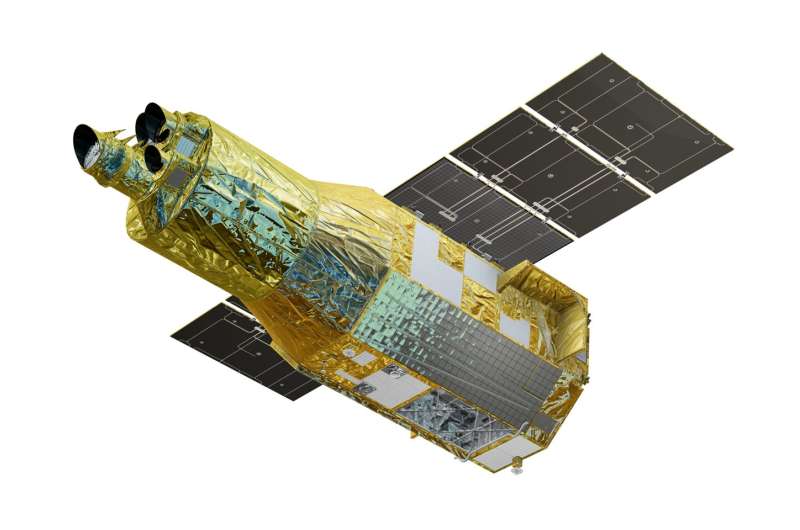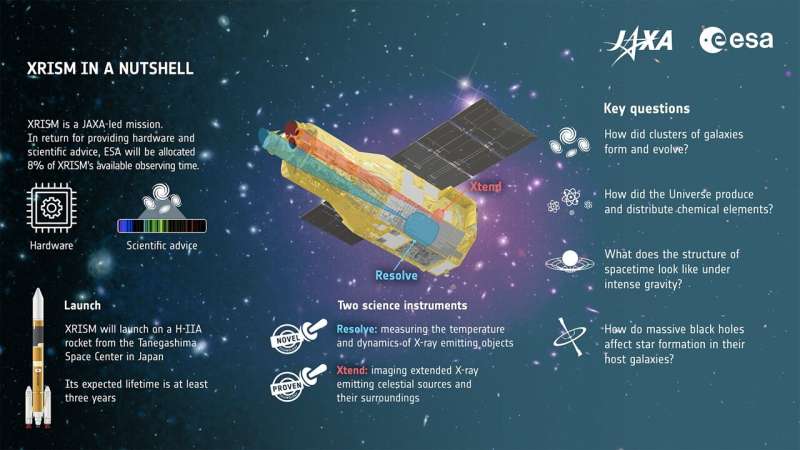This article has been reviewed according to Science X's editorial process and policies. Editors have highlighted the following attributes while ensuring the content's credibility:
fact-checked
trusted source
proofread
Next major X-ray mission set to launch

The X-Ray Imaging and Spectroscopy Mission (XRISM) is ready to launch on 7 September 2023 to observe the most energetic objects and events in the cosmos. In doing so, it will unveil the evolution of the universe and the structure of spacetime.
XRISM is a collaboration between the Japan Aerospace Exploration Agency (JAXA) and NASA, with significant participation from ESA. The launch will be streamed live in Japanese and English on JAXA's YouTube channel.
In return for providing hardware and scientific advice, ESA will be allocated 8% of XRISM's available observing time. This will enable European scientists to propose celestial sources to observe in X-ray light and make breakthroughs in this area of astronomy.
"X-ray astronomy enables us to study the most energetic phenomena in the universe. It holds the key to answering important questions in modern astrophysics: how the largest structures in the universe evolve, how the matter we are ultimately composed of was distributed through the cosmos, and how galaxies are shaped by massive black holes at their centers," says Matteo Guainazzi, ESA project scientist for XRISM.
"XRISM will be a valuable bridge between ESA's other X-ray missions: XMM-Newton, which is still going strong after 24 years in space, and Athena, which is due to launch in the late 2030s."
Unveiling the hot and energetic universe
When we look up at the sky we see stars and galaxies, but these tell us relatively little about the workings of the universe. Invisible to our eyes, the X-ray emitting gas that lies in and between them can reveal so much more.
X-rays are released in the universe's most energetic explosions and hottest places. This includes the super-hot gas that envelops the universe's biggest building blocks: galaxy clusters. JAXA has designed XRISM to detect X-ray light from this gas to help astronomers measure the total mass of these systems. This will reveal information about the formation and evolution of the universe.

XRISM's observations of galaxy clusters will also provide insight into how the universe produced and distributed the chemical elements. The hot gas within clusters is a remnant of the birth and death of stars over the history of the universe. By studying the X-rays emitted by the gas, XRISM will discover which 'metals' (elements heavier than hydrogen and helium) it contains and map how the universe became enriched with them.
Meanwhile, XRISM will peer closer at individual X-ray emitting objects to venture into fundamental physics. The mission will measure the X-ray light from incredibly dense objects such as the active supermassive black holes that lie at the centers of some galaxies; this will help us understand how the objects warp the surrounding spacetime, and to what extent they influence their host galaxies through 'winds' of particles ejected at speeds close to the speed of light.
European contributions to a global effort
"ESA and the European community have a history of involvement in JAXA's high-energy space telescopes," explains Matteo. "Continuing this partnership through XRISM comes with enormous benefits to both space agencies."
Europe's high-energy astronomy community is very well qualified. Members have been involved in setting out the scientific goals of XRISM and were entrusted by JAXA to choose many of the 'test' cosmic objects that the mission will observe to check its performance before the science observation program begins.
On top of this scientific contribution, JAXA has relied on Europe to deliver several pieces of hardware that will be vital to the success of the mission. ESA has provided a space-proven optical telescope to ensure that XRISM always knows where it is pointing, and two separate devices that will together sense Earth's magnetic field and orient the spacecraft accordingly.
Europe has also contributed to XRISM's novel Resolve instrument, which will measure the energy of incoming X-ray photons. This will enable astronomers to work out the temperature and motion of hot X-ray emitting gas with unprecedented accuracy. Resolve is a scientific and technological pathfinder for ESA's future Athena mission, which will fly a very similar instrument.
Keeping Resolve's detector cool—just a fraction of a degree above absolute zero—is vital; European industry provided the 'loop heat pipes' that will take care of this important task. SRON in the Netherlands provided the instrument's six-filter wheel; each filter can be placed over the instrument to serve a different goal. The University of Geneva in Switzerland developed electronics for the filter wheel.
Provided by European Space Agency


















